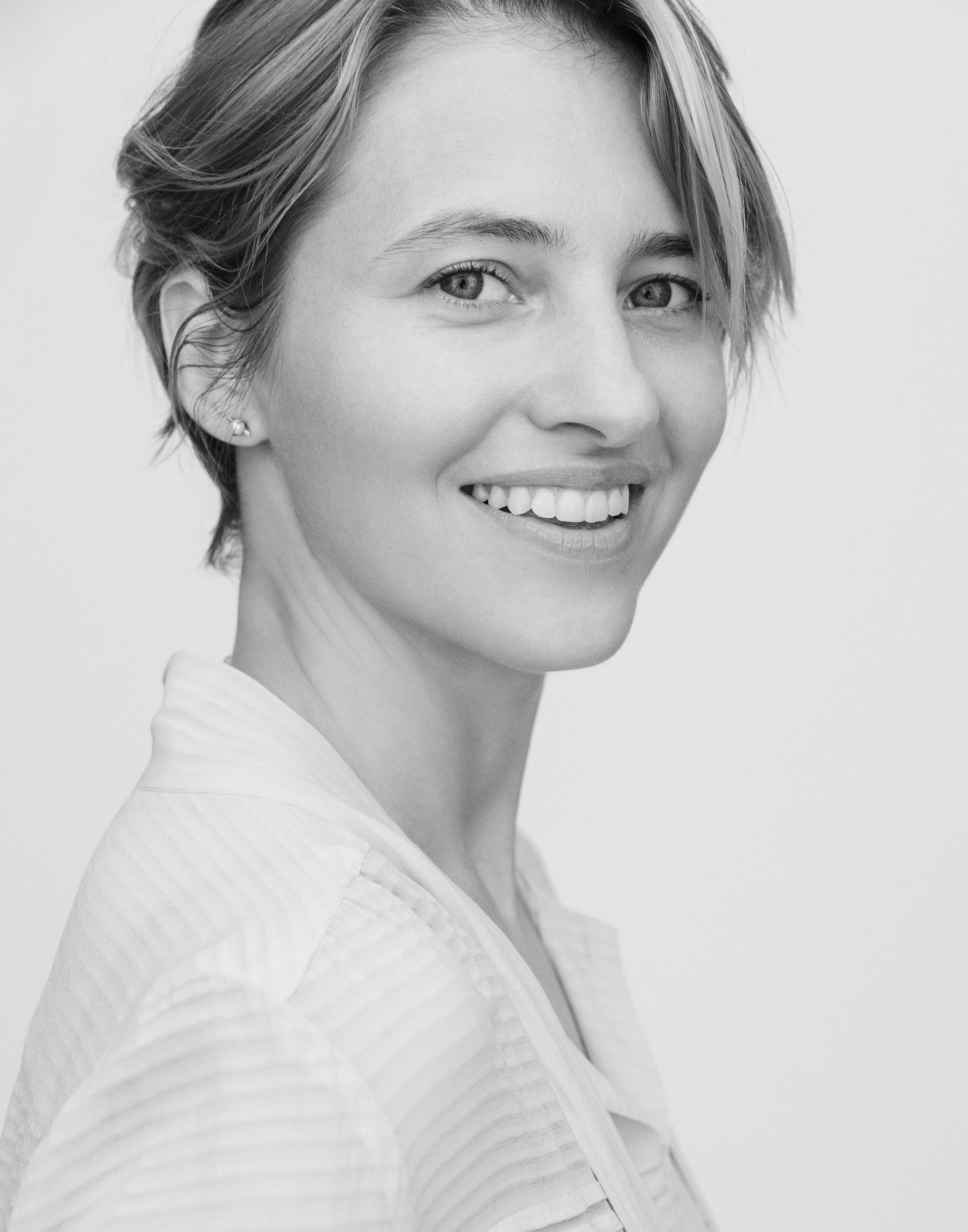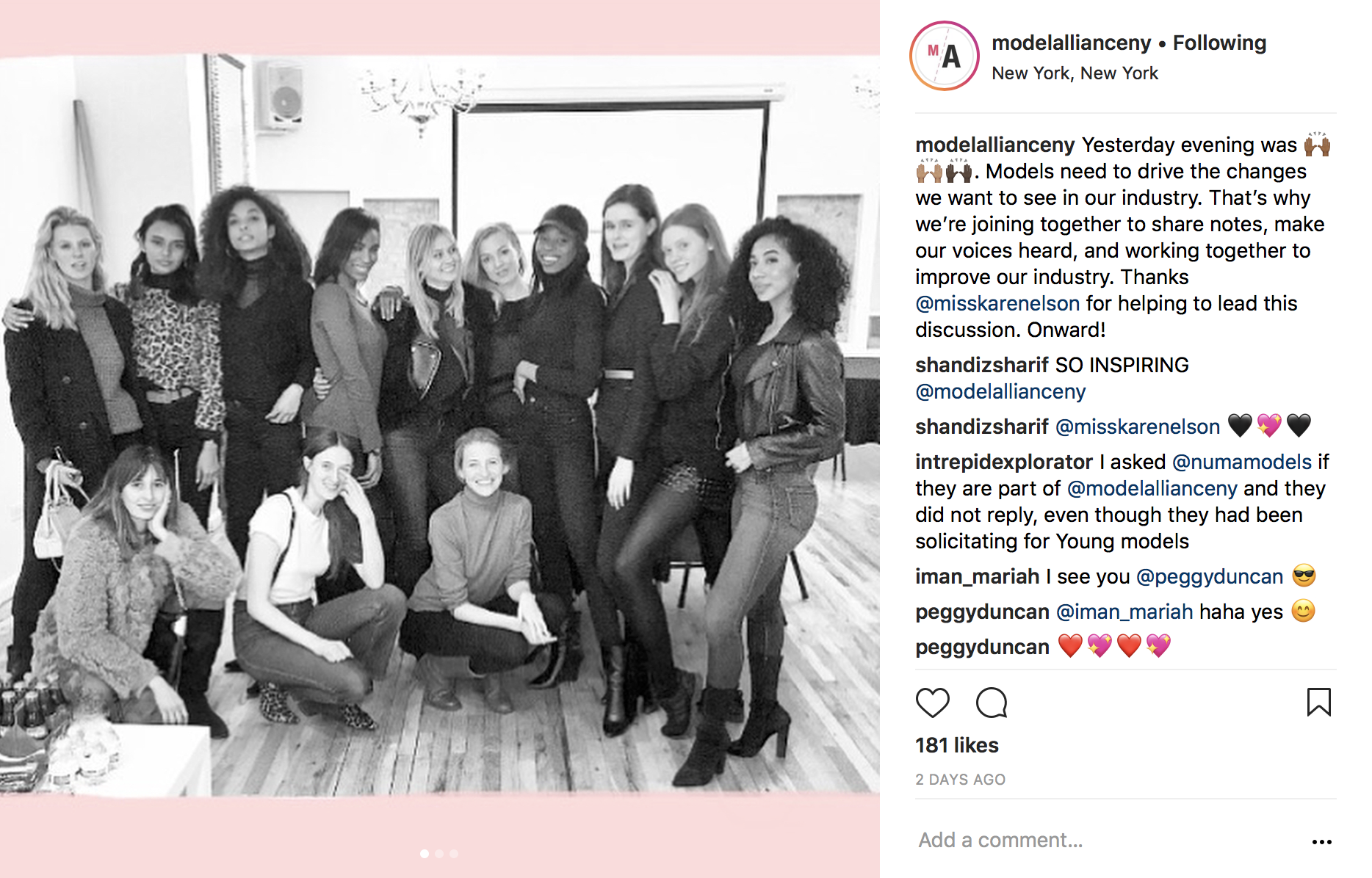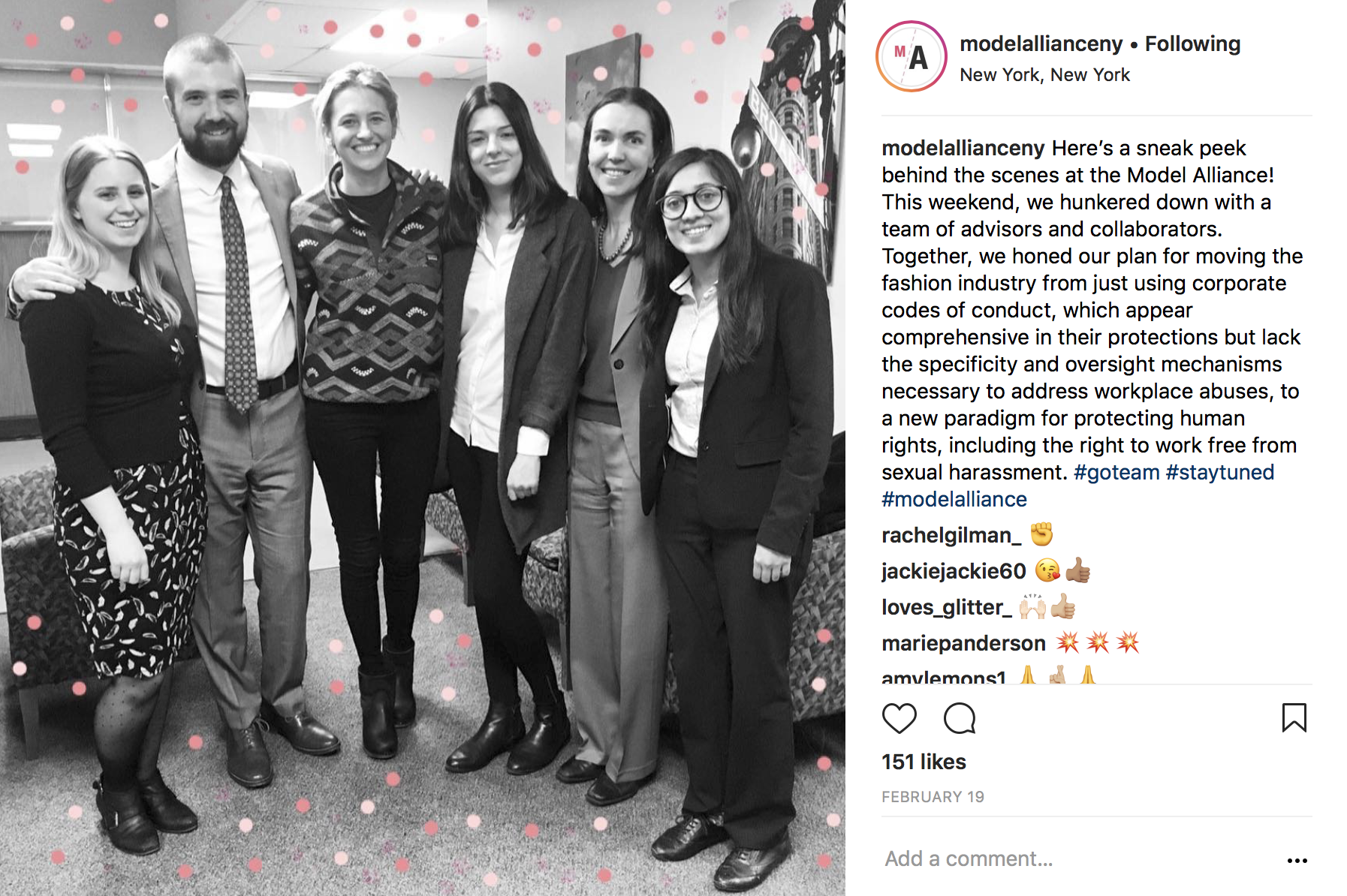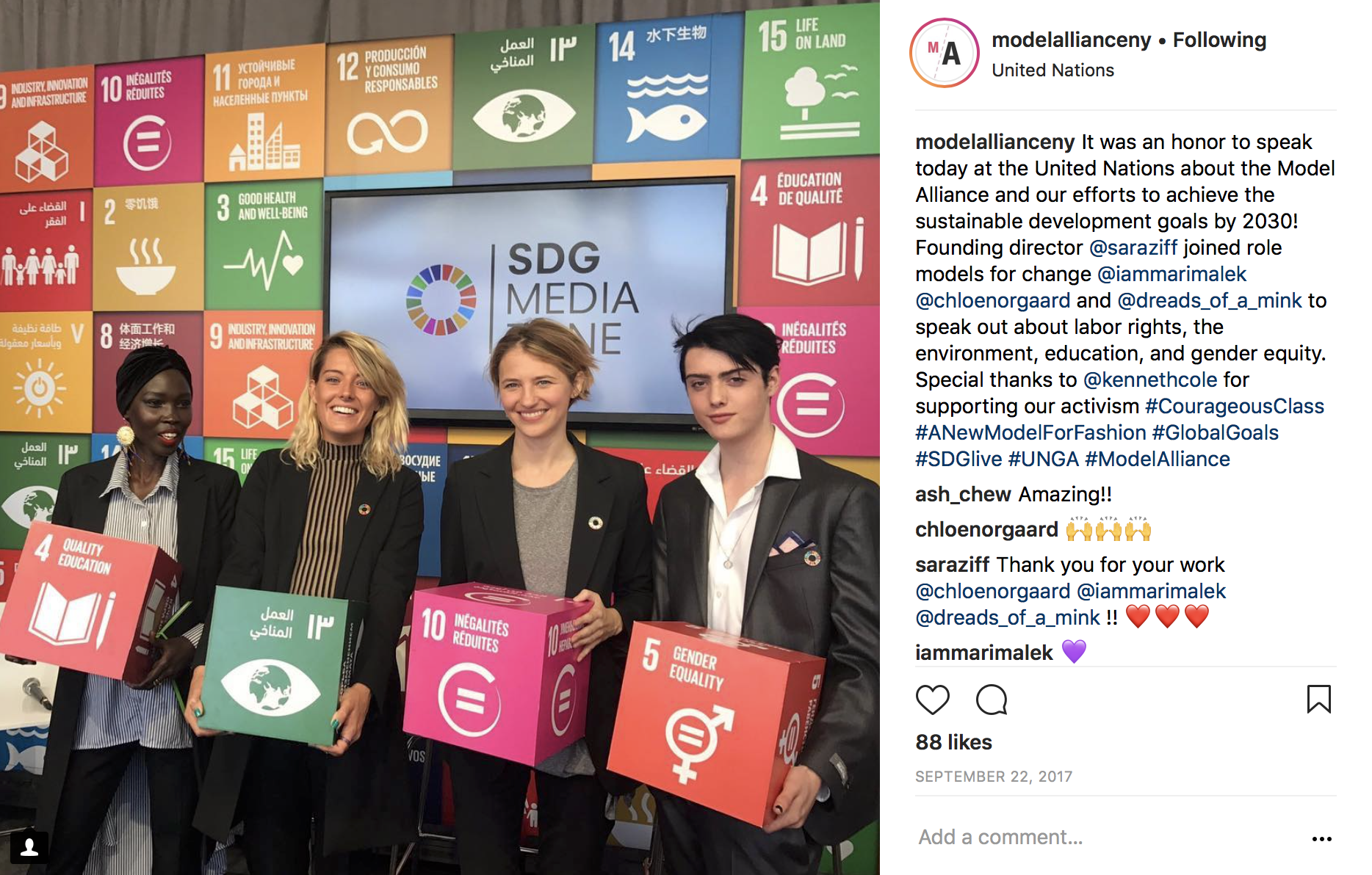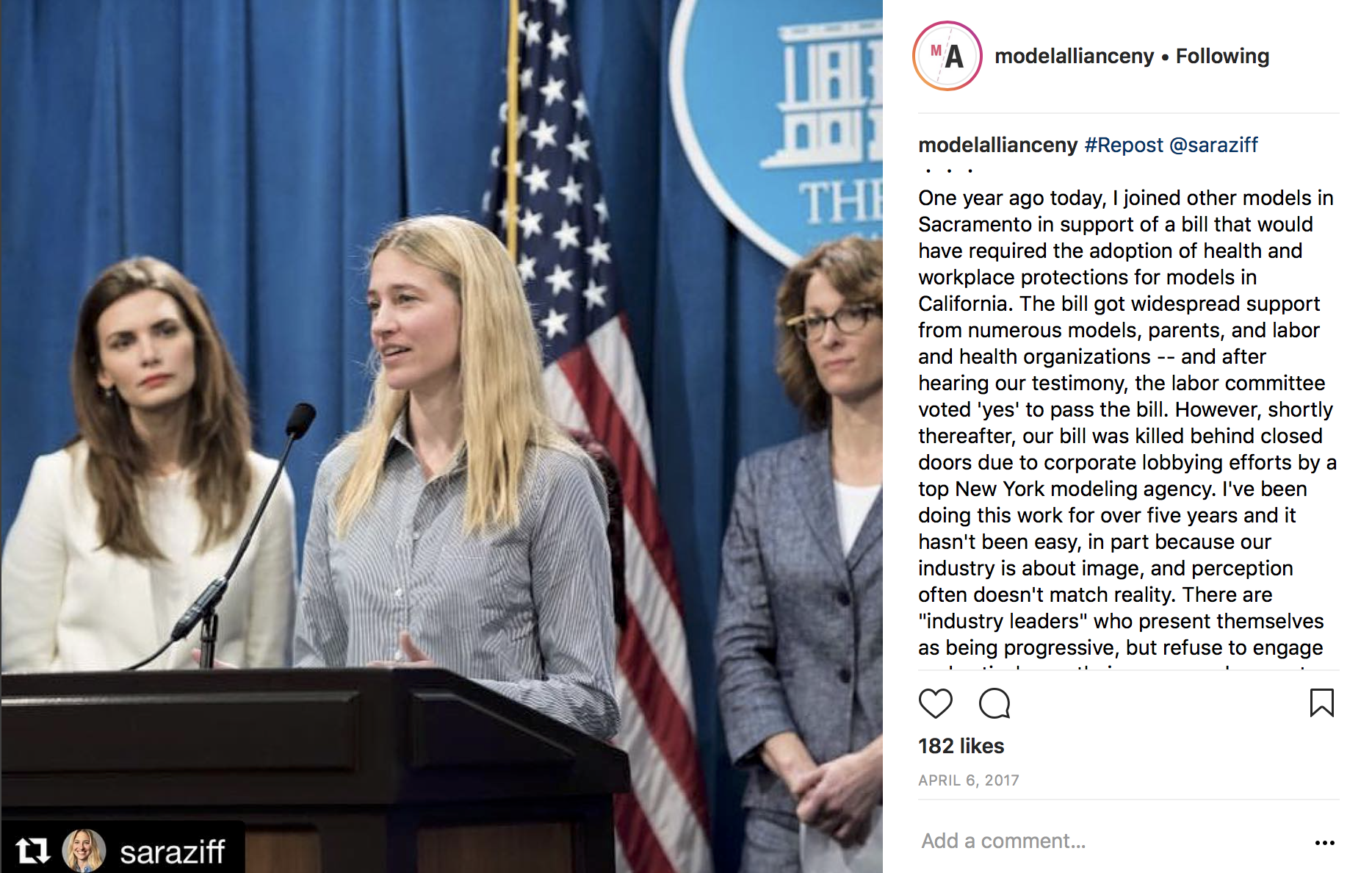Sara Ziff
The professionally beautiful begin their careers as minors. Gisele Bündchen, the highest paid model from 2002-2016 (Kendall Jenner currently holds this ranking)[1] was walking the runway in New York City at age sixteen.[2] Naomi Campbell appeared in the pages of British Elle at age fifteen.[3] Karlie Kloss was posing for fashion spreads at age fourteen[4] and became a Victoria’s Secret Angel by nineteen. Rarely does a model begin her career past the age of twenty. Despite this reality, many models are depicted as adults and treated like adults.
Sara Ziff founded the Model Alliance in 2012 after working as a model from the age of fourteen. The New York City-based organization works to create lasting changes in the modeling industry and ultimately, make the profession less vulnerable to exploitation.
Rachel Kinnard: How would you describe the role of the Model Alliance to someone who doesn't live in New York City, has never met a professional model, someone who's outside of the industry?
Sara Ziff: The Model Alliance is a research, policy, and advocacy organization in the fashion industry. Although the fashion industry appears to be very glamorous, the working conditions for models and other freelancers can be pretty bad. Without adequate legal protections, awareness, and education through combined efforts with various different stakeholders in the industry, models and other people working in the industry will remain vulnerable. We've worked to raise awareness for the poor working conditions in the industry and have also collaborated with various industry stakeholders to put forward legislation and policy initiatives that would create a safer and healthier work environment.
What is the history of models organizing in the fashion industry? Is the Model Alliance the first of its kind or are there any other comparable organizations in other countries?
We're not the first. There actually was an attempt to unionize models about 15 or 20 years ago. I think they did manage to put some predatory people behind bars and did some good organizing work but ultimately were unsuccessful, and that effort dissolved. Because [models] are independent contractors, we are unable to unionize in the traditional sense, but that doesn't mean that we can't work together to create standards and have protections in place. The Model Alliance recognizes that this isn't just unique to our industry. Increasingly we're working in a gig economy where traditional safeguards that apply to employees of companies are not afforded to us, and so we needed to come up with a new model. At the Model Alliance, we're in an experimental phase in thinking about what a new organization in today's labor movement looks like.
Are all models independent contractors and how does that affect their experiences?
It depends where you are in the world. In France, for example, models are considered employees of the agencies. Whereas in the US, the agencies insist that models are independent contractors. The only protections that a model has are through her contract to her agency. That would be fine if you are a supermodel who has the kind of clout to negotiate a favorable contract, but in reality, there are far more people who want to be models. Given the disposable nature of the business, we often just don't have that kind of bargaining power, and we just have to take what we can get. Those contracts to our agencies tend to be very one-sided.
There is a union for models in the UK. Equity is a union that represents other performers. I believe in, I want to say 2010, they formed the division for models and have been pushing for better protections in the UK. For example, they put forward a 10-point code of conduct that was signed by British Vogue.
We've managed to get more traction here in the US. Part of that, I think, has been because we had an early win. Shortly after we formed the Model Alliance in 2012, we did legal research. When we looked at the laws on the books, we found that models that were under 18 were cut out of child labor law. We were not considered child performers like actors, and singers, and dancers, and so we lacked the protection of the Department of Labor.
We introduced the Child Model Act, which passed in 2013 shortly after we first started [the Model Alliance]. That was a significant achievement. I think that maybe when we first formed the Model Alliance, people didn't necessarily take us so seriously, but since we were able to pass legislation very swiftly, I think it made people take notice, and we've gotten quite a lot of traction since then.
Having an impact on legal policy legitimized the organization?
Yeah, and we've had prominent people involved in our efforts. That helps as well. A lot of this is also just reputational. It's about using the power of the press to both raise awareness for our concerns and put pressure on companies to act.
Earlier this week on Instagram, the Model Alliance posted a reminder that models can reach out to you if they feel they’ve experienced inappropriate behavior on the job. What are the resources that you're commonly giving models when they reach out to you?
We hear a whole range of complaints from difficulty getting paid the money they're owed by the client or their own agency, to unresponsive representation. They have an exclusive contract with their agency, but the agency isn't sending them out and submitting them for jobs and they want help getting out of a contract that is basically preventing them from making a living.
Increasingly, especially since October, we've been hearing from people with complaints about sexual harassment and assault. We offer a variety of resources. We'll connect models with crisis and trauma support. We're basically a point of contact to be able to provide whatever resource the model wants.
We've also connected models with attorneys who specialize in representing victims of sexual abuse and labor lawyers who can help them with concerns about contracts and getting paid the money they're owed. That's a substantial part of what we do in addition to the awareness raising and policy work.
We also do research in collaboration with universities. Right now, we have partnerships with Harvard School of Public Health and Northeastern University, and for a couple years now have been working on research focused on eating disorders, the prevalence of eating disorders in the industry, and how those issues are essentially labor issues, getting a better understanding of the pressures that models experience. It's very helpful, obviously, when you're doing policy initiatives and trying to introduce legislation to be able to say, "Look, two-thirds of models are being told that they have to lose weight or they're going to be dropped," and these are people, the vast majority of whom are already considered underweight.
We also have a partnership with Fordham Law School, and their policy advocacy legal clinic is working with us on legal research. That work has informed our legislative initiatives. Their resources and time to this, Fordham Law School's legal clinic has been really instrumental. When you can't afford to have an in-house attorney, having law professors who you can turn to, who can guide the research and even just be there as a resource, and provide moral support, is incredibly helpful.
I would imagine that collecting data is an important part of convincing people and making policy changes.
There are plenty of people who will do surveys, but if you don't have credible PhDs behind you, who can make sure that you're getting an accurate representation of the industry, and you're asking the right questions, and framing the questions in a way that are not going to be biased, then that data actually means something.
The New York Times published the article, “What It’s Truly Like to Be a Fashion Model.”[5] In the comments section, “Chris H” responded, "If I made the choice to be a model, I don't think I'd feel right about complaining of being objectified any more than I would feel okay complaining about being launched into space if I had chosen to be an astronaut." In his eyes, accepting the position of being a model is akin to accepting one's self to be objectified and therefore treated as an object rather than a person.
I just wonder where that lack of empathy comes from, and if it's because models are young beautiful women, and if there's a relationship to feminism and basically demanding to take that form of labor more seriously. In your work, do you have to convince people that modeling is a serious form of labor?
Oh, yeah. I think I spent most of my time, especially in the first couple of years, just trying to help educate the public and reporters that this is an issue that's worth taking seriously, and that we're doing a job like anyone else, and we deserve to be treated with dignity and respect. The initiatives that were already in place were really inadequate. They acknowledged the health concerns because I think concerns about models being overly thin, that's well known, but it was being treated more like a consumer protection issue than it was a labor rights issue.
There didn't seem to be an understanding that in the case of models' physical health and wellbeing, that of course if you have twelve, thirteen, fourteen-year-olds on the runway representing the feminine ideal of beauty, that is going to present an image of a person who is not physically or mentally developed. This isn't just about a thin ideal. It's a question of the power dynamic at play. A thirteen-year-old is a child who deserves to have basic labor protections and who also shouldn't be representing women.
Apart from health and the sexual misconduct, what about issues of diversity in modelling?
It seems like there's more awareness that it's not okay to have an all-white cast than there is an understanding that it's not okay to have an all size zero cast. It's been interesting to speak with various advocates in this space because people tend to focus on the issue that they have experienced firsthand. Bethann Hardison has been a champion of greater racial and ethnic diversity, but I've never heard her talk about concerns about eating disorders or recommending that you shouldn't have to be a size zero to work as a runway model. Similarly, sometimes the people in the public health space are not thinking about the intersection of gender and race.
You really need to look at these issues holistically. I think there are a lot of groups that are doing a good job of trying to promote diversity in terms of the images that we see, and further efforts are needed, but my interest is in how we demand accountability from the industry so that this is not simply about companies having more diverse faces represent their brands but that they actually are accountable to the health and well-being of the people who they hire.
Is the new Condé Nast Code of Conduct something that will create meaningful change?
That is a good question. I've been in meetings with Condé Nast about this.
You were invited to those meetings?
They initially approached me, yeah. They approached me back at the end of October and invited me to participate in meetings that they've held with various industry stakeholders to talk about the problem of sexual misconduct in the industry and how to ensure that everyone that's working for Condé Nast is treated with dignity and respect. I think the code, which I first saw last week and which was announced yesterday, it's a step in the right direction.
Will it be enough? No, absolutely not. There are no provisions for vendor compliance. This Code of Conduct applies to their vendors, and they're asking their vendors, namely agencies, whether they're photo agencies or modeling agencies, to have policies and programs in place to prevent abuse, but there's no mention of provisions for compliance or really other elements like the proposal that I had shared with them now a couple months ago and have continued to seek support for that would really make this meaningful.
Would that involve having some monitor to make sure that the compliance is happening?
Yeah. We're not reinventing the wheel here. In other industries there are independent monitors that ensure compliance. We've seen that with the Coalition of Immokalee Workers in the food industry and the Fair Foods Council. We have seen this in the garment industry after Rana Plaza. I think companies felt compelled to act, and so they signed on to the Accord, which is a binding commitment. It's not voluntary. There are penalties for non-compliance, and it required that the affiliated businesses provide adequate resources for the monitor.
What I've proposed is very much the same thing. We're saying that there should be strong standards for independent contractors and that the models and other people like photo assistants should play a central role in developing those standards. There must to be commitments: a public commitment from the businesses to ensuring dignity and respect. There needs to be monitoring of compliance with the standards by an independent monitor. This is increasingly recognized as the only meaningful way to address concerns when we've seen across industries there have been HR departments that have essentially, they protect the company, not necessarily the individual who's come forward with a complaint. Of course, there is no HR department for independent contractors.
Right, right.
This is an opportunity to really change how we do business in our industry and I think be a model to other industries. I've shared my proposal with Anita Hill and various experts in the field. So far the feedback has been very positive. Another element of the proposal is education. The Condé Nast Code says, and I'm paraphrasing here, that they won't tolerate inappropriate behavior. You have to define what's appropriate and what's not. In our industry where there can be a very blurry line and where bad behavior is often normalized, I think you really need to have trainings and discussions to educate people on their rights and their obligations.
What's the role of the consumer in all of this?
That is a good question. Socially concerned consumers certainly have a role to play. If they appreciate that voluntary codes of conduct have not solved the problem in the past and that it's unrealistic to believe that they're going to solve the problem in the future, then by putting pressure on companies through social media and other ways, I think consumers can influence how businesses address these issues.
Who are people who have been allies with you and pushed the Model Alliance forward?
Certainly, individual models have been involved with our efforts and who's used their platforms to support us, people like Karen Elson who's on our Advisory Board. Coco Rocha was very involved in our child model legislation. Milla Jovovich has been supportive. Then there are some agencies, they're now represented on our Advisory Board, who have been very supportive. Gary Dakin who's the president of JAG Models, which is an agency that represents plus-size models, he's great. Maria Cognata who's the president of Marilyn, the agency that represents me, she's involved. They let me run with it, but when we need the backing of stakeholders in the industry, then they've been great. Also Chris Gay who's the president of Elite Worldwide, and they have multiple agencies in New York and globally, he's been very supportive. The CFDA, when we introduced the child model legislation, they supported that. They also expressed support for our sexual harassment bill, which we've just introduced in New York.
Do you work with a team? Is this what you do every day, full-time?
I'm the main person involved, and this is largely my day to day. I also do consulting work to pay the bills, but this is my job. I have a good group of volunteers. My team has been involved with me since the beginning. Kelly, who developed our website, she's actually the very first person who's been with the Model Alliance and continues to work with us. Meredith, who's a former model turned graphic designer who actually works at Condé Nast, she designs all of our materials. It's not like we have a staff.
I think it's important for people to see the reality of running organizations and what you can achieve even if you are a small group, that you can make a really big impact.
It is really amazing what you can do with just a small, dedicated team of volunteers. The fact is that we have the moral high ground, and we're very committed to this work. We're proposing solutions that ultimately are in everyone's best interest. I think you'd actually find the same thing, even though Time's Up has raised millions of dollars for their legal defense fund, they don't have a staff. Anita Hill's commission doesn't even have a staff. There are smart people who are willing to dedicate their time, but these are not big operations.
Notes
[1] https://www.forbes.com/sites/natalierobehmed/2017/11/21/highest-paid-models-2017-kendall-jenner-ousts-gisele-with-22-million/#65532f712b5c
[2] https://www.vanityfair.com/news/2004/10/gisele-bundchen-fashion-film-debut
[3] https://www.theguardian.com/fashion/2016/mar/19/naomi-campbell-modelling-bob-marley-putin-autobiography-extract
[4] http://www.complex.com/style/2015/02/hottest-fashion-models-right-now/karlie-kloss
[5] https://www.nytimes.com/2017/09/05/fashion/models-racism-sexual-harassment-body-issues-new-york-fashion-week.html

